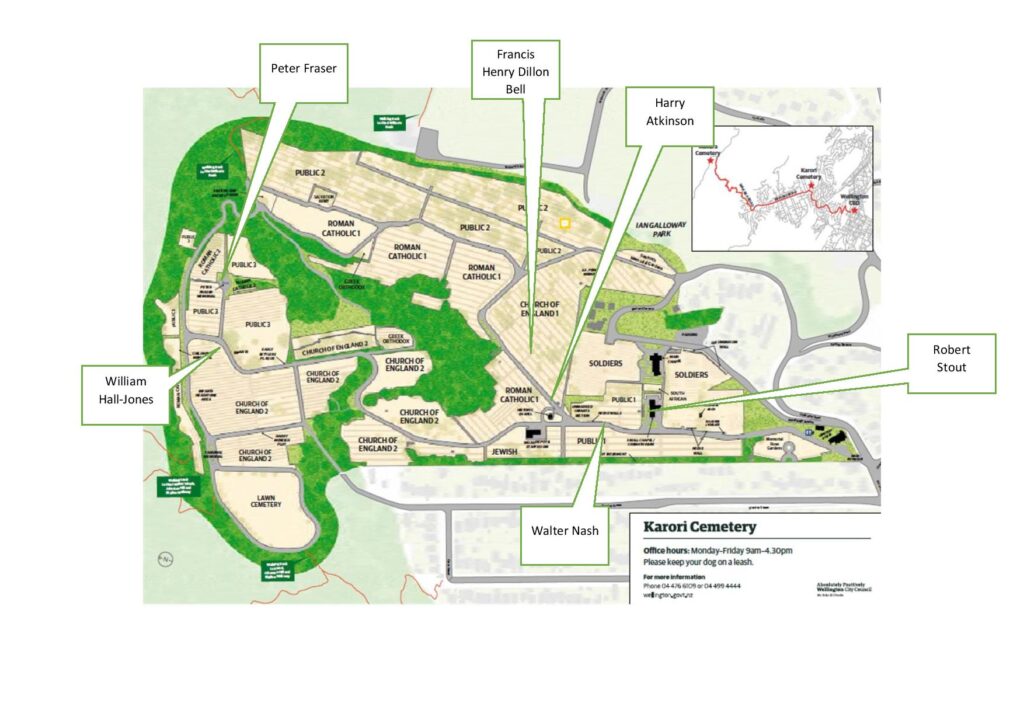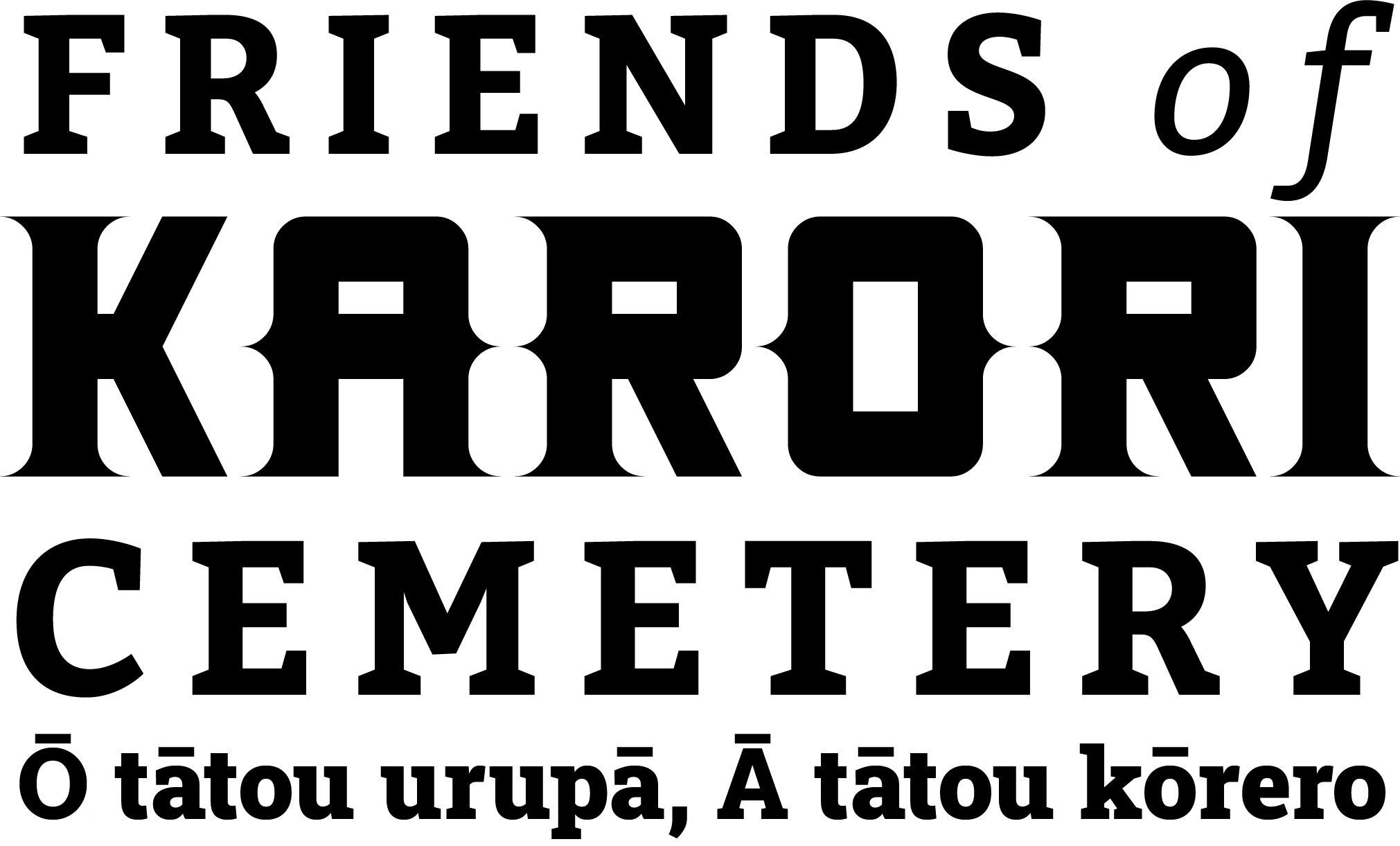Karori Cemetery’s Seven Prime Ministers
The seven Prime Ministers (or Premiers up to 1906) buried or cremated in Karori Cemetery include five who served as Prime Minister for an extensive period – Sir Harry Atkinson, Sir Robert Stout, Peter Fraser, Sir Walter Nash, and Sir Sidney Holland, and two who undertook significant caretaker roles – Sir William Hall-Jones and Sir Francis Bell.
Peter Fraser has the largest memorial, and there is preliminary planning by the Ministry of Culture and Heritage to upgrade this. Sir Harry Atkinson and Sir Francis Dillon Bell are in large plots in the old Anglican area. Sir Walter Nash has a small plaque on the main road near the Small Chapel. Sir Robert Stout was cremated and has a plaque in the Small Chapel. Sir Sidney Holland was cremated, and his ashes scattered. Sir William Hall-Jones has a significant grave not far from Peter Fraser. Below is a map of the Cemetery showing where these seven graves can be visited.

Sir Harry Atkinson
Sir Harry Atkinson was born in England in 1831 and emigrated to New Plymouth in 1849 with his brother Arthur and a group of their friends from the Richmond family. Harry and Arthur purchased land a little south of New Plymouth and became farmers. Harry became a strong supporter of Maori land sales and served in the Taranaki wars. He was elected to the Provincial Government and then to Parliament, quickly becoming Colonial Treasurer and subsequently Premier. He was premier five times through 1876 to 1891 reflecting the volatility of the period, but also his common sense and effectiveness as Colonial Treasurer through an exceptionally difficult period for NZ – and he probably saved New Zealand from bankruptcy. After being defeated by Ballance he retired, joining the Legislative Council, and he died in his office in 1892 at age 61.
Sir Robert Stout
Sir Robert Stout was born in the Shetland Islands in 1844, and he claimed ancestry back to the Viking Kings. He arrived in Dunedin in 1864, and by 1867 he had become an articled law clerk. He was admitted as a barrister and solicitor in 1871 and became an effective trial lawyer. He was elected to the Otago Provincial Council in 1872 and in 1874 he became Provincial Solicitor. He was soon elected to Parliament becoming Attorney-General in 1878 in the government of George Grey. In 1879 he resigned from Parliament citing a need to earn a living in law. In 1884 he was re-elected and formed an alliance with Julius Vogel. He was Premier for 3 years until he lost his seat. Stout re-entered Parliament in 1893 and joined the new Liberal Party, and became heavily involved in the passing of the woman’s suffragette bill. Stout frequently clashed with Seddon, the Liberal leader, as he regarded him as too conservative, but Seddon eventually manouvered Stout out of parliament. In 1899 Stout become Chief Justice, a role he held for 26 years. Stout also became involved in the establishment of the university system and was become a member of the Senate of the University of New Zealand in 1885, and from 1903 to 1923, he was the university’s Chancellor. He played a significant role in the founding of what is now Victoria University of Wellington and the Stout family is remembered by the university’s Stout Research Centre and its Robert Stout Building. With his many-sided interests and immense energy, Stout was one of the most influential architects of a democratic New Zealand.
Sir William Hall-Jones
Sir William Hall-Jones was born in Folkestone, Kent and arrived in Dunedin in 1873. He served on the Timaru Borough Council and won a seat in Parliament in 1890. Richard Seddon appointed him to cabinet in March 1896 and Minister of Public Works during an especially busy period of development. In 1906 he was appointed acting Prime Minister while Seddon was overseas, but Seddon died on the trip home, and he was requested to form an administration. He was Prime Minister for 47 days while Seddon’s funeral was organised, and Joseph Ward returned from England to take over. Hall-Jones was subsequently appointed as High Commissioner in London and on his return was to the Legislative Council. Sir William was an outstanding administrator, a man of great integrity, and a highly effective Minister.
Sir Francis Henry Dillon Bell
Sir Francis Henry Dillon Bell, born in Nelson in 1851, was the eldest son of the former New Zealand Company agent and Cabinet Minister Sir Dillon Bell. He studied law and joined a firm now known as Bell Gully. He was elected mayor of Wellington in 1891, 1892 and 1896, but after a brief skirmish with parliamentary politics, he returned to law and quickly rose to prominence in the NZ law scene becoming president of the New Zealand Law Society from 1901 to 1918. He became a close friend and confidant of Prime Minister Bill Massey and joined his Ministry from 1912 to 1926 holding many portfolios. When Massey died in office in 1925, he was formally appointed as Prime Minister which he held for 17 days while the Reform Party elected a new leader. Bell is regarded as one of the outstanding lawyers in NZ history, and he also held leadership roles over lengthy periods with New Zealand cricket, rugby, racing and with the Freemasons. He died in 1936 at age 85.
Peter Fraser
Peter Fraser was born in 1884 and raised in the Scottish Highlands. He left education early in order to support his family, but unemployment led him to emigrate to New Zealand in 1910. He worked as a wharfie, and became involved in union affairs and the establishment of what became the Labour Party. He spent a year in jail on charges of sedition for opposing conscription for the First World War. In 1918 he became the Labour member for Wellington Central. He became a senior Cabinet Minister in Michael Joseph Savage’s ministry in 1935 introducing universal secondary schooling, free maternity care, free pharmaceuticals, and subsidised doctor’s visits. Following Savage’s death in 1940 he became the Leader of the Labour Party and Prime Minister. He actively participated in the Allied conduct of the Second World War, astutely appointing Freyberg as Commander in Chief and he became a confidant of both Churchill and Roosevelt. With Walter Nash’s assistance he played a key role in the setting up of the United Nations and in so doing revealed himself to be a statesman of world stature. However, the Labour Party lost the 1949 election, and Peter Fraser died in 1950 at age 66.
Sir Walter Nash
Sir Walter Nash was born in England in 1882. In 1909 he came to NZ with his wife and sought clerical roles. He became involved in the formation of the Labour Party, and in 1922 he was elected national secretary, a job he excelled at. In 1929 he was elected Member for Hutt. In the first Labour government in 1935 Nash became Minister of Finance and was ranked third in the government after Michael Joseph Savage and Peter Fraser. Nash spent much of the war overseas representing NZ’s interests, and after the war he became involved in the creation of the United Nations, the International Monetary Fund, post war reconstruction planning and new world trade rules. Labour lost the 1949 election and soon after Peter Fraser died. Nash was elected as his successor and in 1957 he led the Labour Party to electoral victory in a tight election. However, the country’s finances were in much worse shape than had been revealed, and he raised taxes on cigarettes and liquor to prop up government income – the ‘Black Budget’ – which led to the party’s defeat in the 1960 election. Nash remained on as leader, earning the title of the grand old man of New Zealand politics, and he became active in the protest movements against the Vietnam War. In 1963 he was replaced by Arnold Nordmeyer. He died in 1968 at the age of 86.
Sir Sydney Holland
Sir Sidney George Holland was born in Canterbury in 1893. His father was mayor of Christchurch and a member of Parliament for Christchurch North (now called Fendalton). He served in the first war and was badly injured at Messines in 1917. After the war he and his brother started up an engineering business. He succeeded his father in the Fendalton electorate and quickly became prominent in the establishment of the National Party, becoming leader in 1940. Holland led the National Party to its first election victory in 1949 and dismantled many state controls imposed by the Savage/Fraser Labour government. In 1951, having confronted locked out dockers and coal miners intent on what he called “industrial anarchy”, he called a snap election and was re-elected Prime Minister. In its second term, the National government signed the ANZUS defence agreement with Australia and the United States. Holland led his party to a third consecutive victory in 1954. Following ill health in 1957, he stepped down as Prime Minister to be replaced by Keith Holyoake. Holland died in 1961 at age 68. He was Prime Minister for eight years and played a leading role in consolidating the place of the National Party in NZ politics.
